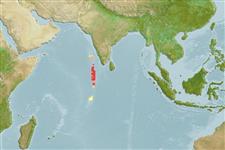Actinopterygii (ray-finned fishes) >
Perciformes (Perch-likes) >
Tripterygiidae (Triplefin blennies) > Tripterygiinae
Etymology: Helcogramma: Greek, helkos, -eos, -ous = ulcer, sore + Greek, gramma = letter, mark (Ref. 45335). More on author: Fricke, Randall.
Environment / Climate / Range
Ecology
Marine; demersal; depth range 0 - 10 m (Ref. 12235). Tropical, preferred ?
Western Indian Ocean: presently endemic to the Maldives.
Size / Weight / Age
Maturity: Lm ? range ? - ? cm
Max length : 2.8 cm SL male/unsexed; (Ref. 12235)
Dorsal
spines
(total): 15 - 17;
Dorsal
soft rays
(total): 9-11;
Anal
spines: 1;
Anal
soft rays: 17 - 21;
Vertebrae: 35 - 36. Diagnosis: Dorsal fin III + XIII+ 10, 2nd fin twice height of 1st; anal fin I + 16-18; pectoral rays 15 (3+6+6); pelvic fin I, 2, spine short and hidden, segmented rays simple, partially united by membrane. Vertebrae 10 + 25-26. LL total lateral scales 36-38; tubed 13-21 (16-17) scales, ends below 3rd dorsal fin; nape, belly, 1st dorsal fin and anterior anal-fin base scaleless, caudal-fin base with 2 rows of scales. Mandibular pores 3+2-1+3. Labial folds and orbital cirrus absent. Head length 3.4 in SL; eye 2.4, maxilla 2.3 in HL. Males overall reddish with bluish dots and streaks on head, forming stripes anteriorly on body, ventrally light grey, fins pigmented; females paler, without spots and stripes, ventrally white, fins transluscent (Ref. 75031).
Eggs are hemispherical and covered with numerous sticky threads that anchor them in the algae on the nesting sites (Ref. 240). Larvae are planktonic which occur primarily in shallow, nearshore waters (Ref. 94114).
Life cycle and mating behavior
Maturity | Reproduction | Spawning | Eggs | Fecundity | Larvae
Fricke, R. and J.E. Randall, 1992. Tripterygiid fishes of the Maldives Islands, with descriptions of two new species (Teleostei: Blennioidei). Stuttg. Beitr. Naturkd. A Biol. (484):1-13. (Ref. 12235)
IUCN Red List Status (Ref. 115185)
CITES (Ref. 94142)
Not Evaluated
Threat to humans
Harmless
Human uses
More information
ReferencesAquacultureAquaculture profileStrainsGeneticsAllele frequenciesHeritabilityDiseasesProcessingMass conversion
Tools
Special reports
Download XML
Internet sources
